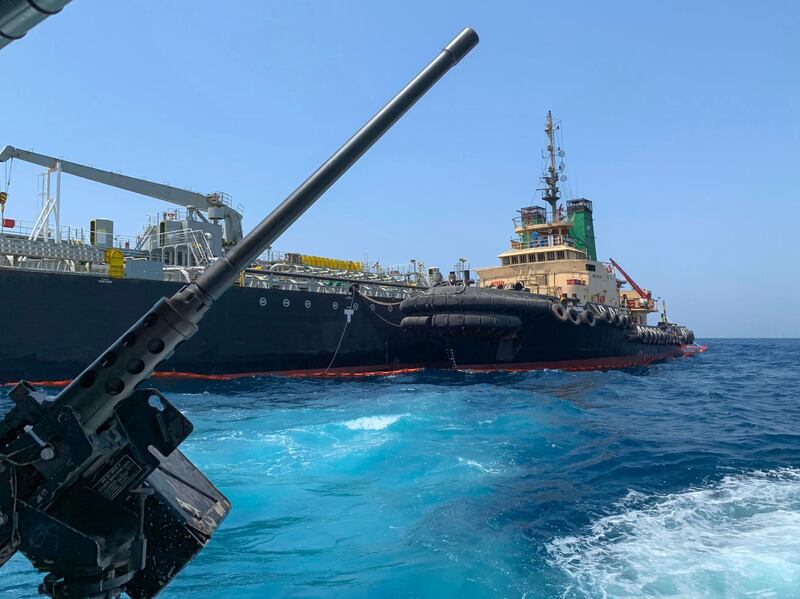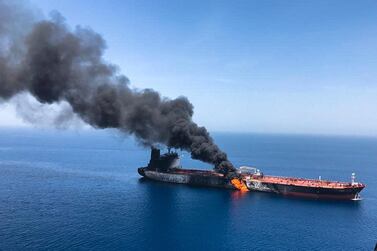After tankers, the theatre of US-Iran confrontation shifted to the skies, with the downing of an American drone, and to Basra, with rocket attacks on an ExxonMobil camp.
Talk swirled of planned US strikes against Iranian military sites, then called off, and of cautions to the Iranians conveyed through Oman. Where could things go from here, and what does that mean for oil markets? There are at least five outcomes along a continuum.
A deal, even a retouched version of US President Barack Obama’s Joint Comprehensive Plan of Action, or an accord of little practical impact, would allow President Donald Trump to claim victory as he has done with North Korean nukes and Mexican trade. Sanctions on Iran would be eased in return for its continuing compliance with the limits on its nuclear programme and perhaps some vague concessions on missiles and regional destabilisation.
Iranian oil exports would recover, putting 1-1.5 million barrels per day of oil back on the market, which would cause a sharp drop in prices. The Opec+ group would have to accommodate this, requiring Saudi Arabia and its Arabian Gulf allies to bear most of the burden. If they did not cut back substantially, prices would fall back to the $40 per barrel range.
In the second case, both sides could tacitly step back from the brink, which would require the US to issue waivers for purchases of Iranian oil, abandoning its “zero exports” target, and drop plans to block petrochemical exports. Iranian exports hovering around 1 million barrels per day, as in the Obama-era sanctions, would mildly depress prices, as when unexpected waivers late last year took Brent crude below $55 per barrel.
In the third case, today’s state would continue: Iran under increasingly strict sanctions, and retaliating with a series of relatively small and mostly deniable attacks, on shipping, strikes against infrastructure, continuing to fire on US drones, and encouraging proxy allies to make pinprick attacks on American targets and oil sites in Iraq. The leaks of a planned US attack could themselves be intended as a warning to Tehran not to escalate further.
The two tanker strikes in the Gulf of Oman have already caused Lloyd's of London insurance to declare the area a war risk zone. Ships entering this area would pay about an extra $180,000 in insurance, or 10 cents per barrel for a very large crude carrier, not a negligible figure. Countries using the Gulf, excluding Iran itself, would lose $500 million per year in the extra insurance on their crude exports alone.
Of course, this is more than offset by the $2.40 per barrel (3.9 per cent) rise in prices on the news of the drone’s shooting down. A continuation of attacks could embed a small risk premium in the oil price but is overshadowed by gloomy trade news.
At some point, the main customers for Gulf oil and gas would feel the need to protect their lifeline. Trump has tweeted often enough that the US is not any more dependent on the region’s crude.
India has deployed two ships in the Gulf of Oman, the Chennai and Sunayna, to protect its merchant vessels. At some point, China, which has a naval base at Djibouti, and Japan could join them. Russia would also see an opportunity to insert itself into the Gulf, as it has done other crises in Syria, Libya and Venezuela.
A multinational marine patrol would win back some of the support lost by the Trump administration’s erratic Middle East policy. That could contain the immediate problem. But the involvement of other leading powers, with conflicting interests, would render the situation more intractable and, in the long term, more dangerous. The US navy would be tied up escorting ships which would remain vulnerable, sapping its ability to act in other areas such as the South China Sea.
Fourthly, in response to some further provocation from Tehran, the US could begin the strikes apparently called off on Thursday. Then Iran would itself likely retaliate further with more attacks on tankers, Iraqi facilities or elsewhere.
The threat to petroleum supplies alone, and building of stocks by wary consumers, would probably add several dollars more to the price. Probably actual production or exports would not be seriously disrupted. Bypass pipelines and strategic storage would cover for a few days of precautionary shutdowns or rerouting of ships.
The fourth situation could quickly escalate into the fifth: a large-scale American military assault on Iranian assets across the region, met by an unconstrained response from Tehran. Iranian exports would halt entirely, and as with Iraq after the first Gulf War, might not rebound significantly for years.
Shipping through the Gulf could be temporarily interrupted, affecting not only oil but also liquified natural gas (LNG), petrochemicals, aluminium and other commodities. Depending on their location, LNG buyers would scramble for oil or Russian gas as a replacement.
Red Sea traffic would also be harassed, though less seriously. Iranian power generation could be disrupted and electricity and gas exports to Turkey and Iraq shut down, meaning another hot and angry summer in Basra. Transit through the Strait of Hormuz would be restored quickly, but a large part of Iraq’s almost 5 million barrels per day oil output could be put offline, and the chaos would risk an Isis resurgence.
In this scenario, oil prices may briefly touch $100, falling back but remaining elevated by a permanent loss of Iranian and Iraqi supply. But as with the 2003 invasion of Iraq, incalculable ramifications would-be set-in train across the region.
Robin M. Mills is CEO of Qamar Energy, and author of The Myth of the Oil Crisis








